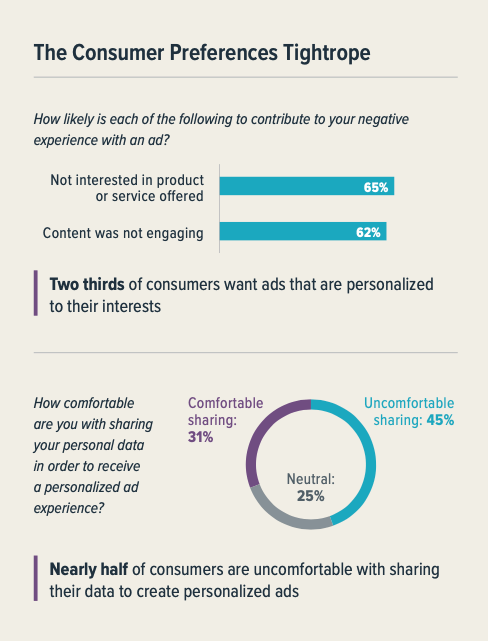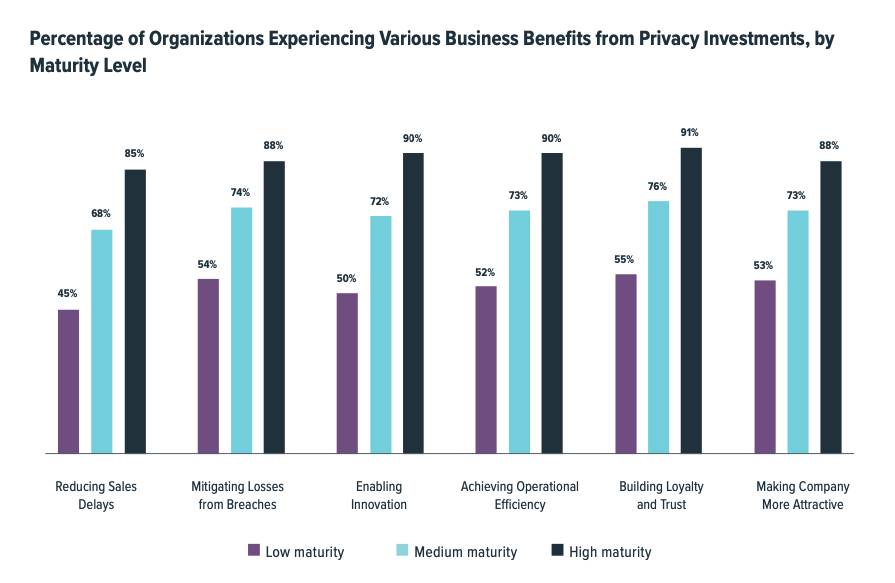When it comes to winning the trust of consumers and earning access to their data, businesses have a long way to go. In a poll conducted by KPMG, 86% of respondents said they feel a growing concern about data privacy, while 78% expressed fears about the amount of data being collected.
Data privacy compliance should be a brand priority as the world increasingly shifts toward an expectation that businesses and marketers treat consumer data with respect. If your goal state is (and it should be) a marketing strategy powered by first-party data that is built to both drive growth and increase customer lifetime value and loyalty, your customers need to know exactly how you’re planning on using their information.
Consumers are more concerned than ever with brand values, mission, and larger role in society. So why are so many businesses missing the opportunity to establish trust with consumers when it comes to data?
Making data privacy transparency a brand pillar not only shows your commitment to bettering the lives of your customers but results in long-term benefits for your business.
And it starts with understanding what consumers want.
What consumers (actually) want when it comes to data privacy
Too many people on both sides of the equation oversimplify the situation at hand: consumers want more privacy, and marketers want to serve personalized campaigns to specific users at whatever cost. But there’s a lot more to it.
Many people are uncomfortable with the ways advertisers track and target them across the open web, on social networks, and at the search bar. But at the same time, many of the same people don’t like getting peppered with irrelevant ads for things they’ll never buy.
The vast majority of marketers don’t have sinister intentions in mind when it comes to user data, they are simply trying to do their jobs and drive the best ROI on their campaigns.
When it comes down to the brass tacks, the majority of consumers actually want ads targeted toward their interests, according to research from Boston Consulting Group. It’s just that nearly half feel uncomfortable about what they have to give up in order for that to happen.

Source: Boston Consulting Group
Resolving the paradox might be simpler than you think. Consumers want to understand how their data is being used, and they also want a certain amount of control over what information advertisers can access and how they can leverage it.
If your brand is transparent about what data you’re collecting, what you’ll do with it, and what benefits consumers will get as a result, they’re more likely to share their data. According to global research conducted by Accenture about consumer attitudes on data collection, 73% of consumers said they’re willing to share more when brands were transparent about the data they collected.
Brands can be resistant to change, and there is some support for the idea that more transparency can actually spook customers. But that’s extremely short-term thinking. Data privacy is front-of-mind for many people; offering a clear, mutual, consensual exchange of value is the future, even if it’s not standard now.
Leading the way always includes a level of risk, but the tea leaves are clear in this case. If you are not willing to be honest with your customers, you are diminishing any chance of building lasting relationships. In a world of data mistrust, you can’t afford to dig yourself into a bigger hole by failing to be upfront.
Evolve to embrace data transparency and earn long-term customer loyalty
Treat data collection as an opportunity. You should not only create a strategy that is data compliant but also take advantage of the shift to a privacy-first world as a way to make transparency a foundational part of your culture. That means not waiting until you have no other choice.
Waiting for the law to act as a forcing function to take action on data transparency will just serve as clear evidence that your brand isn’t putting customers first. And today’s consumers are very good at sniffing out instances of brands behaving performatively or inauthentically.
Taking action now shows that your organization is committed to change and gives you a leg up on your competition that might still be prioritizing the short-term bottom line over consumer privacy and long-term growth potential for their business.
You can start preparing your brand to get more transparent about data usage by taking the following steps to put together a comprehensive privacy policy:
- Work with your team to figure out how you’re going to be using customer data in your marketing and beyond.
- Explain what data you’re collecting and how you’re going to use it. Describe the benefits consumers will receive, from more personalized and relevant content to a better user experience. Get specific for your customers who want to dig into the details!
- Post it on your website and anywhere else you’re going to be utilizing customer data to deliver ads.
Once you’ve implemented your new privacy policy, make sure you get the word out. Put out a press release, post about it on your blog, and feature it in your marketing campaigns.
For example, The Guardian posted a clear-cut explanation of what they do with the data they collect. The video explains where data preferences can be accessed, describes what benefits consumers can expect in return for sharing their data, and lets the customer know that their data is in safe hands.
You want your customers to know that they can trust you with their data and that your business goes above and beyond to prioritize transparency.
Invest in data privacy to open up long-term brand advantages
Your short- and long-term goals for your business are likely aligned with two foundational marketing objectives: drive growth for your business and build a lasting relationship with your customers.
Organizations with high privacy maturity show significant benefits across key business factors like loyalty, innovation, and operational efficiency, according to Cisco’s 2021 Data Privacy Benchmark Study:

Source: Cisco
It just goes to show that valuing your customers’ privacy is good business karma. Take care of the people that matter to your business and they will take care of you.
According to a poll conducted by Sprout Social about the evolution of transparency, brands build equity and healthy relationships with consumers every time they prioritize honest interactions no matter where they occur. Nearly nine in 10 people are more likely to stick by a business during a crisis if it has a history of being transparent. And 89% of people say a business can regain their trust by admitting to a mistake and being transparent about the steps it will take to resolve the issue.
In the very near future, you will have no other choice but to comply with regulations and restrictions around data privacy. You can get ahead of the issue and start reaping the brand benefits before they become the status quo, or you can wait until you have to make the change. The competitive advantage is there for the taking.
Advocate for data ethics in advertising
Authenticity is a major brand differentiator in the market these days, and words need to be followed by actions to establish data transparency as a brand pillar. And huge brands with household names are using their position as market leaders to advocate for a better approach to data privacy.
Brands like Ikea, L’Oréal, Mars, Mastercard, P&G, Shell, Unilever, and Visa, joined forces in 2020 to put together the first guide to data ethics for advertisers from the World Federation of Advertisers. It centered on the following four principles:
- Respect: All data usage should respect the people behind the data and companies need to strive to understand the interests of all parties and use consumer data to improve people’s lives.
- Fairness: Data usage should aim to be inclusive, acknowledge diversity and eliminate bias rather than dividing groups. Brands need to examine their data sets, mindsets, and governance approach to ensure they are inclusive in the way they use data.
- Accountability: Consumers expect companies to have open and transparent data practices backed up by robust global and local governance. The same standards should also be applied across partners, suppliers, publishers, and platforms.
- Transparency: Although the online advertising ecosystem is complex, brands should apply transparency principles and work towards more open and honest data practices, particularly as AI and machine-learning approaches start to automate decisions.
If you’re not protecting consumer data and prioritizing transparency, your business isn’t just failing your customers, it’s limiting your brand’s potential to expand and build trust with new audiences.
You can’t drive growth in the long term without investing in real customer connection. If you don’t embrace data transparency, your marketing performance is going to suffer. It really is that simple.
Do the right thing for your customers and your business. Establish data privacy as a brand pillar and show your customers that you care about their concerns and needs. The future success of your business will thank you.







Responses